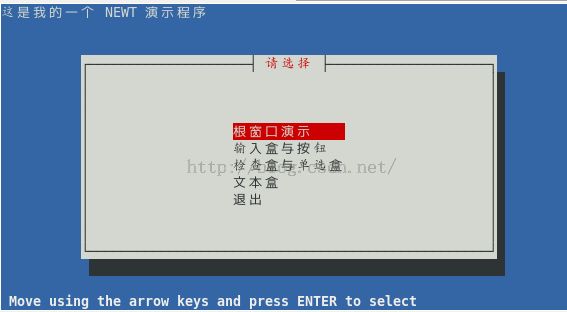RedHad系统安装窗口界面开发库NEWT
一、简介
NEWT是在Linux下一个基于文本方式的窗口开发工具,最初是为RedHad Linux的安装程序而设计的。NEWT提供C语言的应用程序接口(API),它不直接进行低级屏幕操作,是在S-Lang库上实现的。编程时包含头文件#include <newt.h>,在Linux上用gcc编译时带-lnewt 参数。
考虑到 Red Hat Linux 有软盘安装这一安装方式,安装代码运行于有限的资源环境中,特别是在有限的文件空间中。NEWT 的大小一开始就成为一个重要的问题。为了最小化它所占的空间,NEWT 的设计思想有下面几点:(1)NEWT由C语言写成,而不是C++;(2)NEWT所有窗口的生成都是基于堆栈的数据结构,窗口的外观都是统一的模板,不由程序员修改;(3)输入设备只支持终端键盘。
Linux系统安装过程NEWT的界面:

二、详解
1、简单程序
#include <stdio.h>
#include <newt.h>
int main()
{
newtInit();
newtCls();
int rc = newtWinChoice(("Disc Found"), ("OK"), ("Skip"),
("To begin testing the media before installation press %s.\n\n"
"Choose %s to skip the media test and start the installation."),
("OK"), ("Skip"));
if (rc == 1) {
newtDrawRootText(0,0,"you choose:ok");
newtRefresh();
}
sleep(3);
newtFinished();
return 0;
}编译:gcc -o newt newt.c -lnewt
运行:

2、NEWT解析
(1)组件(Components)每在NEWT中,每一个可显示的项目称为组件。组件主要有两类:Form组件与非Form组件。非Form组件是除Form以外的所有组件。Form逻辑地组织各个组件成为一个功能集。Form是一个容器组件,让其他组件都装在其上,有点类似gtk+中的垂直盒(Vbox)和水平盒(Hbox)。当一个应用准备从用户中获得输入,就要run一个Form,这也类似于gtk+中的gtk_widget_show()。Form组件可以包含其他任何组件,也包含其他的Form作为子Form。
每一个组件都是由一个属于newtComponent数据类型的变量唯一标志,这一变量必须由生成该组件的函数建立,而不能由程序员自己建立。属于newtComponent数据类型的变量其实只是一个指针。
(2)NEWT程序的开始与结束
int newtInit(void); void newtCls(void);newtInit()必须是每个NEWT程序第一个调用的函数,用于初始化数据结构和重置终端于raw模式。大多数应用在newtInit()后立即调用newtCls(),newtCls()用于清除屏幕(这个函数不是必须的,但有助于优化屏幕 )。
当一个NEWT程序准备结束时,就要调用以下函数。
int newtFinished(void);newtFinished()恢复终端在调用newtInit()前的状态,重置原来的输入状态。若没调用这函数,终端需重启才能回到命令行状态。
(3)编译NEWT程序
在Linux上用gcc编译时带-lnewt参数。以下所说的函数都可在/usr/include/newt.h(Red Hat Linux 7.1)中找到。
NEWT定义了若干个标志 (FLAG),这里仅介绍常用的几个(若要使用多个标志,可对多个标志进行与操作 ('|')):
NEWT_FLAG_RETURNEXIT 当在组件上按回车时程序退出
NEWT_FLAG_HIDDEN 输入不回显,大多数应用在输入密码的情况
NEWT_ENTRY_SCROLL 允许滚动输入
NEWT_FLAG_WRAP 换行时整个单词换行
NEWT_FLAG_BORDER 加边框
NEWT_FLAG_MULTIPLE 允许多选
(4) 根窗口(root window)
终端所显示的背景,只有不被任何窗口遮盖的部分称为根窗口。一般地,应用不需使用到根窗口,而把文字写到属于自己的窗口上。所有组件都不应放在根窗口上。根窗口只用于显示一些辅助信息,例如程序的作者姓名、版本等。NEWT提供两种在根窗口显示文字的方式,它们是唯一能越出组件自己当前窗口写文字的NEWT函数。
void newtDrawRootText(int left, int top, const char *text);该函数用于在根窗口指定位置写出text字苻串,left和top为字苻串text的开始处,left是屏幕x坐标,top是屏幕y坐标。Left和top允许为负数。屏幕坐标原点在显示器的左上角,x坐标从原点出发至左向右增大,y坐标从原点出发至上向下增大。点(10,5)表示以左上角为原点x=10,y=5,而left,top为负,表与为正数方向相对。点(-10,5)表以右上角为原点x=10,因此点(10,5)与点(-10,5)在屏幕左右两边相对,同理点(10,5)与点(10,-5)在屏幕上下两边相对。
在文本方式下,通常屏幕的最后一行用于显示帮助信息,如每个快捷键所对应的功能等。这一提示行称为帮助行(help line)。正如前面所述,NEWT是基于堆栈,压栈Push操作显示帮助行,出栈Pop操作删除帮助行。基于栈的操作后面还回遇到。
void newtPushHelpLine(const char * text); void newtPopHelpLine(void);newtPushHelpLine()用于显示帮助行,text为所要显示的字苻串指针,若为NULL则显示缺省的帮助行。NewtPopHelpLine()则删除帮助行。
(5)非正常退出
在缺省情况下,NEWT程序不能非正常退出,尽管大多数Unix程序可以通过按Ctrl-z强迫退出,但在NEWT不支持此功能。因NEWT初始化时屏蔽所有终端信号。
typedef void (*newtSuspendCallback)(void); void newtSetSuspendCallback(newtSuspendCallback cb);但可通过调用newtSetSuspendCallback()实现Ctrl-z强迫退出的功能,cb是相应的回调函数,它不带参数,只做清理工作,如newtFinished()等。早期Red Hat Linux的安装程序当运行到硬盘分区时,若你使用Fdisk则屏幕回到命令行状态运行Fdisk进行分区,退出Fdisk时又回到当前窗口。要实现这种功能,在回调函数中加入下面两个函数:
void newtSuspend(void); void newtResume(void);newtSuspend()告诉NEWT程序回到终端初始化前的状态,做需要做的工作。如需要回到NEWT界面,调用newtResume()恢复。
(6)窗口
生成窗口有两种主要方式:
int newtCenteredWindow(int width, int height, const char * title); int newtOpenWindow(int left, int top, int width, int height, const char * title);由名字可知,newtCenteredWindow()在屏幕中心生成窗口,width为窗口宽度,height为窗口高度,title为窗口标题字串指针,标题文字为红色。由newtOpenWindow()生成的窗口位置由left,top 确定,其余参数同上。
所有窗口的删除都是用同一种方式,由于NEWT是基于堆栈来操作,只有在栈顶的窗口才能被删除,位于栈顶的窗口即当前你能看到的不被任何其他窗口遮盖的窗口。
void newtPopWindow(void);这函数删除屏幕最顶层的窗口,并重画被该窗口遮盖的部分。
(7)Form
正如前述那样,Form是一个容器组件,同一时间只能生成一个Form,所有组件都必须放在Form上,然后运行它。生成一个Form用以下函数:
newtComponent newtForm(newtComponent vertBar, const char * help, int flags);vertBar是垂直滚动条,help是提示信息,通常这两个参数都不会用到,用NULL即可,flags就是前述的标志。该函数返回标志所生成的Form 的变量。
把组件放在 Form 上用以下函数:
void newtFormAddComponent(newtComponent form, newtComponent co); void newtFormAddComponents(newtComponent form, ...);newtFormAddComponent()只放一个组件在Form上,而newtFormAddComponents()则可放多个组件,最后用NULL结束。然后就运行它:
newtComponent newtRunForm(newtComponent form);其中Form参数是newtForm()返回的变量。
删除一个 Form(当一个Form被删除时,其上的组件一同被删除,并释放内存资源):
void newtFormDestroy(newtComponent form);(8)按钮
几乎所有的Form都包含最小一个按钮。按钮分两类:完全按钮(full button)和紧缩按钮(compact button)。完全按钮富有立体感,紧缩按钮则单调些。
newtComponent newtButton(int left, int top, const char * text); newtComponent newtCompactButton(int left, int top, const char * text);newtButton()生成完全按钮,letf,top指定该按钮位置,text是指向按钮文字的指针,该函数返回按钮的newtComponent变量。NewtCompactButton()生成紧缩按钮,参数及返回值同上。
(9)标签
标签是NEWT程序最简单的组件,用于显示给定的文本但不允许用户输入。
newtComponent newtLabel(int left, int top, const char * text); void newtLabelSetText(newtComponent co, const char * text);newtLabel()生成标签组件,并返回它的newtComponent变量,参数left,top指定标签组件位置,text为给定的文本。NewtLabelSetText()用于动态改变标签组件的文字,co是要改变的标签组件,test是要改变的字串指针。
(10)输入盒(Entry Box)
输入盒可让用户输入字符串到 Form 中然后由应用接收。
newtComponent newtEntry(int left, int top, const char * initialValue, int width,char ** resultPtr, int flags); void newtEntrySet(newtComponent co, const char * value, int cursorAtEnd); char * newtEntryGetValue(newtComponent co);newtEntry()生成输入盒组件,其中initialValue为初始化字符串指针,若不需则用NULL,width为宽度,resultPtr为指向当前输入的字符,flags为标志。Flags设为NEWT_ENTRY_SCROLL,当输入的字串长度等于输入盒的宽度时输入盒将往后滚动,否则不能再输入;Flags设为 NEWT_FLAG_HIDDEN输入不回显,主要应用于输入密码方面。NewtEntrySet()用于动态地改变输入盒的内容,value为字符串指针,cursorAtEnd实质是一个逻辑变量,由于C语言没有逻辑类型变量,仅用int代替,若为0则表TRUE,指定光标跟随,非0光标不跟随输入。NewtEntryGetValue()返回输入的字串。
(11)检查盒 (Checkbox)
检查盒可对其代表的内容通过按空格键切换预定的各种状态。
newtComponent newtCheckbox(int left, int top, const char * text, char defValue,const char * seq, char * result); char newtCheckboxGetValue(newtComponent co);newtCheckbox()生成一个检查盒,text标明它所代表的内容,defValue为缺省值也即初始值,seq为切换的顺序,result指向当前状态。如 defValue='@',seq="@*X",则初始时为[@],当按空格键==》[*]再按空格键==》 [X],如此循环。若result为NULL则需NewtCheckboxGetValue()获取当前状态。
(12)单选按钮(Radio Button)
单选按钮的外观与检查盒非常相似。不同的是单选按钮是由若干个组成一个集合,当一个单选按钮被选中时,其他单选按钮则被清除。若集合中只有一个单选按钮,它总会被选中,因而就失去了选择的意义。
newtComponent newtRadiobutton(int left, int top, const char * text, int isDefault, newtComponent prevButton); newtComponent newtRadioGetCurrent(newtComponent setMember);newtRadiobutton()建立单选按钮集合,text为代表单选按钮的字符串指针,isDefault是逻辑开关,为1表逻辑TRUE, 初始状态为选中;为0表FALSE,初始状态为不选中。若当前单选按钮是集合中的第一个,prevButton为NULL让newtRadiobutton()自动建立一个集合;若不是第一个,prevButton为前一个由newtRadiobutton()生成的单选按钮。
(13)范围(Scale)
范围组件通常用于制作水平进度条。
newtComponent newtScale(int left, int top, int width, long long fullValue); void newtScaleSet(newtComponent co, unsigned long long amount);newtScale()生成水平进度条,width为宽度,fullValue为进度条的最大值。NewtScaleSet()用于设置进度条的值。
(14)文本盒 (Textbox)
文本盒能让终端显示一个文本块。newtTextbox()建立一个文本盒,其中flags可设为NEWT_FLAG_WRAP、NEWT_FLAG_SCROLL和它们的与操作。文本盒建立后,由newtTextbox()填充文本。
newtComponent newtTextbox(int left, int top, int width, int height, int flags); void newtTextboxSetText(newtComponent co, const char * text);(15)滚动条(Scrollbar)
newtComponent newtVerticalScrollbar(int left, int top, int height, int normalColorset, int thumbColorset);newtVerticalScrollbar()生成滚动条,normalColorset为滚动条颜色,thumbColorset为滚动块颜色。
(16)列表盒(Listboxe)
列表和是 NEWT 中最重要的组件,允许多选或单选。
newtComponent newtListbox(int left, int top, int height, int flags); int newtListboxAppendEntry(newtComponent co, const char * text, const void * data); void * newtListboxGetCurrent(newtComponent co); void newtListboxSetWidth(newtComponent co, int width); void newtListboxSetCurrent(newtComponent co, int num); void newtListboxSetCurrentByKey(newtComponent co, void * key);newtListbox()生产列表盒,flags可设为NEWT_FLAG_SCROLL、NEWT_FLAG_RETURNEXIT、NEWT_FLAG_BORDER、 NEWT_FLAG_MULTIPLE和它们的与操作。NewtListboxAppendEntry() 用于在当前列表盒最后追加一个列表项,每一个个列表项由key唯一标志,key可为任意类型,只要能和其他列表项区别开来就可以了。data为key数据。操作列表盒的函数还有:
void newtListboxSetEntry(newtComponent co, void * key, const char * text); int newtListboxInsertEntry(newtComponent co, const char * text, const void * data, void * key); int newtListboxDeleteEntry(newtComponent co, void * key); void newtListboxClear(newtComponent co);
3、范例
代码newt2.c:#include <newt.h>
#include <stdio.h>
#include <stdlib.h>
void rootwin_show()
{
newtCls();
/* 请观察 left,top 为正数 , 为负数地情形 */
newtDrawRootText(0, 0, "左上角");
newtDrawRootText(-6, 0, "右上角");
newtDrawRootText(0, -3, "左下角");
newtDrawRootText(-6, -3, "右下角");
/* 注意 helpline 缺省时的内容 */
newtPushHelpLine(NULL);
newtRefresh();
sleep(10);
newtPushHelpLine("我的帮助行");
newtRefresh();
sleep(3);
newtPopHelpLine();
newtRefresh();
sleep(1);
}
void label_button()
{
newtComponent form, label, entry, button,cb;
char * entryValue;
newtCls();
newtCenteredWindow(50,10,"输入与标签演示");
/*left,top 是相对于中心窗口而言 */
label = newtLabel(10, 1, "请输入 :");
entry = newtEntry(19, 1, NULL, 20, (const char **)&entryValue, NEWT_FLAG_SCROLL);
newtEntrySet(entry,"\0",0);
button = newtButton(10, 5, "完全按钮");
cb=newtCompactButton(25,5,"紧缩按钮");
form = newtForm(NULL,NULL, 0);
newtFormAddComponents(form, label, entry, button,cb, NULL);
newtRunForm(form);
if(*entryValue!='\0')
{
newtDrawRootText(0,0,"你输入了 :");
newtDrawRootText(12,0,entryValue);
}
else
newtDrawRootText(0,0,"无输入 !");
newtRefresh();
newtFormDestroy(form);
sleep(5);
}
void check_radio()
{
newtComponent form, checkbox, rb[3], button,lable1,lable2;
char cbValue,cv[2];
int i;
newtCls();
newtOpenWindow(10, 8, 40, 11, "检查盒与单选盒演示");
lable1 = newtLabel(2, 1, "检查盒 :");
checkbox = newtCheckbox(10, 1, "A checkbox", ' ', " *X", &cbValue);
lable2 = newtLabel(2, 4, "单选盒 :");
rb[0] = newtRadiobutton(10, 3, "Choice 1", 1, NULL);
rb[1] = newtRadiobutton(10, 4, "Choice 2", 0, rb[0]);
rb[2] = newtRadiobutton(10, 5, "Choice 3", 0, rb[1]);
button = newtButton(15, 7, "退出");
form = newtForm(NULL, NULL, 0);
newtFormAddComponent(form, checkbox);
newtFormAddComponent(form, lable1);
newtFormAddComponent(form, lable2);
for (i = 0; i < 3; i++)
newtFormAddComponent(form, rb[i]);
newtFormAddComponent(form, button);
newtPushHelpLine("< 空格健 > 选择");
newtRefresh();
newtRunForm(form);
for (i = 0; i < 3; i++)
if (newtRadioGetCurrent(rb[0]) == rb[i])
{ newtDrawRootText(0, 0, "单选盒 :");
newtDrawRootText(9, 0, "第");
if(i==0)newtDrawRootText(11, 0,"1");
if(i==1)newtDrawRootText(11, 0,"2");
if(i==2)newtDrawRootText(11, 0,"3");
newtDrawRootText(12, 0, "个");
}
newtDrawRootText(0, 3, "检查盒状态 :");
cv[0]=cbValue;cv[1]='\0';
newtDrawRootText(13, 3, cv);
newtRefresh();
newtFormDestroy(form);
sleep(5);
}
void test()
{
char message[] = "This is a pretty long message. It will be displayed "
"in a newt textbox, and illustrates how to construct "
"a textbox from arbitrary text which may not have "
"very good line breaks.\n\n"
"Notice how literal \\n characters are respected, and "
"may be used to force line breaks and blank lines.";
newtComponent form, text, button;
newtCls();
text = newtTextboxReflowed(1, 1, message, 30, 5, 5, 0);
button = newtButton(12, newtTextboxGetNumLines(text) + 2, "退出");
newtOpenWindow(10, 5, 37,
newtTextboxGetNumLines(text) + 7, "文本盒");
form = newtForm(NULL, NULL, 0);
newtFormAddComponents(form, text, button, NULL);
newtRunForm(form);
newtFormDestroy(form);
}
main()
{
newtComponent ls,fm;
int p = 1, q = 2, r = 3, s = 4, t = 5, *u;
newtInit();
do {
newtCls();
newtRefresh();
newtDrawRootText(0,0,"这是我的一个 NEWT 演示程序");
newtCenteredWindow(50,10,"请选择");
ls = newtListbox(18,3,5,NEWT_FLAG_RETURNEXIT);
newtListboxAppendEntry(ls,"根窗口演示",&p);
newtListboxAppendEntry(ls,"输入盒与按钮",&q);
newtListboxAppendEntry(ls,"检查盒与单选盒",&r);
newtListboxAppendEntry(ls,"文本盒",&s);
newtListboxAppendEntry(ls,"退出 ",&t);
newtPushHelpLine(" Move using the arrow keys and press ENTER to select");
fm = newtForm(NULL,NULL,0);
newtFormAddComponents(fm,ls,NULL);
newtRunForm(fm);
u = newtListboxGetCurrent(ls);
newtPopWindow();
newtFormDestroy(fm);
switch(*u) {
case 1:
rootwin_show();
break;
case 2:
label_button();
break;
case 3:
check_radio();
break;
case 4:
test();
break;
case 5:
newtFinished();
exit(0);
}
} while(1);
}编译运行:gcc -o newt2 newt2.c -lnewt



三、总结
(1)Newt是在S-Lang库的基础上开发的,S-Lang库参考:https://en.wikipedia.org/wiki/S-Lang_%28programming_library%29。(2)Newt的库还有很多接口,可以参考网上其他的文档。
(3)若有建议,请留言,在此先感谢!